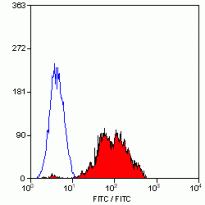ARG22972
anti-CD29 / Integrin beta 1 antibody [4B7R]
anti-CD29 / Integrin beta 1 antibody [4B7R] for Flow cytometry,IHC-Formalin-fixed paraffin-embedded sections,Immunoprecipitation and Human
Overview
| Product Description | Mouse Monoclonal antibody [4B7R] recognizes CD29 / Integrin beta 1 Mouse anti Human CD29 monoclonal antibody, clone 4B7R recognizes the human integrin beta 1 subunit, also known as CD29, a ~130 kDa (red) 115 kDa (non-red) single pass type I transmembrane glycoprotein expressed by most leucocytes and mesenchymal stem cells.Integrin receptors are involved in the regulation of a variety of important biological functions, including embryonic development, wound repair, hemostasis and prevention of programmed cell death. They are also implicated in abnormal pathological states such as tumor directed angiogenesis, tumor cell growth, and metastasis. Surface expression of CD29 on human natural killer cells can be reduced by pretreatment with the glutathione-S-transferase inhibitor diethyl maleate (Horvath-Arcidiacono et al. 2003) |
|---|---|
| Tested Reactivity | Hu |
| Tested Application | FACS, IHC-P, IP |
| Specificity | The clone 4B7R recognizes all CD29 / Integrin beta 1 conformations (total CD29 / Integrin beta 1). |
| Host | Mouse |
| Clonality | Monoclonal |
| Clone | 4B7R |
| Isotype | IgG1 |
| Target Name | CD29 / Integrin beta 1 |
| Antigen Species | Human |
| Immunogen | Occular melanoma cell line V+B2. |
| Conjugation | Un-conjugated |
| Alternate Names | CD29; Glycoprotein IIa; Fibronectin receptor subunit beta; VLAB; MSK12; CD antigen CD29; FNRB; GPIIA; VLA-4 subunit beta; VLA-BETA; MDF2; Integrin beta-1 |
Application Instructions
| Application Suggestion |
|
||||||||
|---|---|---|---|---|---|---|---|---|---|
| Application Note | IHC-P: This product requires antigen retrieval using heat treatment prior to staining of paraffin sections. FACS: Use 10 µl of the suggested working dilution to label 10^6 cells in 100 µl. * The dilutions indicate recommended starting dilutions and the optimal dilutions or concentrations should be determined by the scientist. |
Properties
| Form | Liquid |
|---|---|
| Purification | Purification with Protein G. |
| Buffer | PBS and 0.09% Sodium azide |
| Preservative | 0.09% Sodium azide |
| Concentration | 1 mg/ml |
| Storage Instruction | For continuous use, store undiluted antibody at 2-8°C for up to a week. For long-term storage, aliquot and store at -20°C or below. Storage in frost free freezers is not recommended. Avoid repeated freeze/thaw cycles. Suggest spin the vial prior to opening. The antibody solution should be gently mixed before use. |
| Note | For laboratory research only, not for drug, diagnostic or other use. |
Bioinformation
| Database Links | |
|---|---|
| Gene Symbol | ITGB1 |
| Gene Full Name | integrin, beta 1 (fibronectin receptor, beta polypeptide, antigen CD29 includes MDF2, MSK12) |
| Background | Integrins are heterodimeric proteins made up of alpha and beta subunits. At least 18 alpha and 8 beta subunits have been described in mammals. Integrin family members are membrane receptors involved in cell adhesion and recognition in a variety of processes including embryogenesis, hemostasis, tissue repair, immune response and metastatic diffusion of tumor cells. This gene encodes a beta subunit. Multiple alternatively spliced transcript variants which encode different protein isoforms have been found for this gene. [provided by RefSeq, Jul 2008] |
| Function | Integrins alpha-1/beta-1, alpha-2/beta-1, alpha-10/beta-1 and alpha-11/beta-1 are receptors for collagen. Integrins alpha-1/beta-1 and alpha-2/beta-2 recognize the proline-hydroxylated sequence G-F-P-G-E-R in collagen. Integrins alpha-2/beta-1, alpha-3/beta-1, alpha-4/beta-1, alpha-5/beta-1, alpha-8/beta-1, alpha-10/beta-1, alpha-11/beta-1 and alpha-V/beta-1 are receptors for fibronectin. Alpha-4/beta-1 recognizes one or more domains within the alternatively spliced CS-1 and CS-5 regions of fibronectin. Integrin alpha-5/beta-1 is a receptor for fibrinogen. Integrin alpha-1/beta-1, alpha-2/beta-1, alpha-6/beta-1 and alpha-7/beta-1 are receptors for lamimin. Integrin alpha-4/beta-1 is a receptor for VCAM1. It recognizes the sequence Q-I-D-S in VCAM1. Integrin alpha-9/beta-1 is a receptor for VCAM1, cytotactin and osteopontin. It recognizes the sequence A-E-I-D-G-I-E-L in cytotactin. Integrin alpha-3/beta-1 is a receptor for epiligrin, thrombospondin and CSPG4. Alpha-3/beta-1 may mediate with LGALS3 the stimulation by CSPG4 of endothelial cells migration. Integrin alpha-V/beta-1 is a receptor for vitronectin. Beta-1 integrins recognize the sequence R-G-D in a wide array of ligands. Isoform 2 interferes with isoform 1 resulting in a dominant negative effect on cell adhesion and migration (in vitro). In case of HIV-1 infection, the interaction with extracellular viral Tat protein seems to enhance angiogenesis in Kaposi's sarcoma lesions. When associated with alpha-7/beta-1 integrin, regulates cell adhesion and laminin matrix deposition. Involved in promoting endothelial cell motility and angiogenesis. Involved in osteoblast compaction through the fibronectin fibrillogenesis cell-mediated matrix assembly process and the formation of mineralized bone nodules. May be involved in up-regulation of the activity of kinases such as PKC via binding to KRT1. Together with KRT1 and GNB2L1/RACK1, serves as a platform for SRC activation or inactivation. Plays a mechanistic adhesive role during telophase, required for the successful completion of cytokinesis. Integrin alpha-3/beta-1 provides a docking site for FAP (seprase) at invadopodia plasma membranes in a collagen-dependent manner and hence may participate in the adhesion, formation of invadopodia and matrix degradation processes, promoting cell invasion. Isoform 5: Isoform 5 displaces isoform 1 in striated muscles. [UniProt] |
| Calculated MW | 88 kDa |
| PTM | The cysteine residues are involved in intrachain disulfide bonds. |
Images (1) Click the Picture to Zoom In






